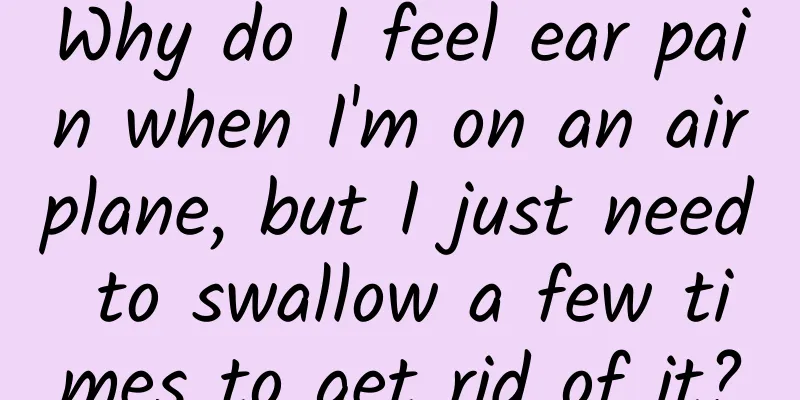Why do I feel ear pain when I'm on an airplane, but I just need to swallow a few times to get rid of it?

|
Author: Kang Xiaoyan, First Hospital of Shanxi Medical University Reviewer: Zhang Sulin, Chief Physician, Union Hospital Affiliated to Tongji Medical College, Huazhong University of Science and Technology Have you ever felt strange pressure changes in your ears when taking off or landing? Or have you ever felt your ears were blocked after swimming? In both cases, we often just swallow a few saliva to eliminate the discomfort. Why is that? In fact, these experiences are related to a mysterious and important human structure - the Eustachian tube. Although it is not well known, its health directly affects our hearing and comfort. Today, we will unveil the mystery of the Eustachian tube and understand its role in our body. 1. What is the Eustachian tube? The Eustachian tube, also known as the Eustachian tube, is a long, thin tube that connects the middle ear tympanic cavity to the nasopharynx. Although this tube is inconspicuous, it plays a vital role. It not only helps regulate the pressure in the middle ear, but also prevents the fluid from the nasopharynx from flowing back into the middle ear, and promotes the discharge of excess secretions in the middle ear. Figure 1 Copyright image, no permission to reprint 2. The function of the Eustachian tube 1. Pressure Regulator: When we take off or land on an airplane, we may feel that our ears are blocked. This is caused by the imbalance between the external air pressure and the air pressure in the middle ear. The Eustachian tube opens briefly when we swallow or yawn, allowing air to enter or leave the middle ear, thereby balancing the internal and external air pressure and reducing discomfort. Figure 2 Copyright image, no permission to reprint 2. Middle ear cleaner: The Eustachian tube is also responsible for cleaning the middle ear. It transports secretions and exfoliated cells in the middle ear to the nasopharynx through the swinging of cilia, and finally excretes them from the body through swallowing, thus keeping the middle ear environment clean and healthy. 3. Immune barrier: In addition to regulating pressure by opening, the Eustachian tube is also an "immune defense line" that can prevent pathogens from the nasopharynx (such as bacteria and viruses) from entering the middle ear, thereby avoiding otitis media. Symptoms of Eustachian Tube Dysfunction Eustachian tube dysfunction can lead to a number of problems, including the following. 1. Stuffy ears and hearing loss: When the Eustachian tube cannot effectively regulate air pressure, negative pressure may occur in the middle ear, causing the eardrum to retract and affecting hearing. 2. Self-inflicted hyperacusis: If the Eustachian tube is abnormally open, when the patient speaks, the Eustachian tube's barrier to sound waves disappears, and the sound waves enter the tympanic cavity through the abnormally open Eustachian tube, causing symptoms such as self-inflicted hyperacusis or tympanic membrane agitation. 3. Fluid accumulation in the middle ear: When the drainage function of the Eustachian tube is blocked, the fluid in the middle ear cannot be cleared in time, which may lead to fluid accumulation in the middle ear and even affect hearing. 4. Otitis media: When the immune barrier function of the Eustachian tube fails, pathogens can easily invade the middle ear and cause inflammation. Tips for maintaining a healthy Eustachian tube 1. Regular swallowing movements, such as chewing gum or drinking water, can help the Eustachian tube open naturally. 2. Keep the nasopharynx healthy: prevent respiratory infections and reduce the possibility of Eustachian tube obstruction. 3. Reasonable diet: Avoid excessive intake of spicy, greasy and other irritating foods to prevent nasopharyngeal inflammation. 4. Seek medical treatment promptly: Patients with serious conditions need to see a doctor promptly, use medication as prescribed by the doctor, or undergo Eustachian tube insufflation. For patients whose symptoms cannot be relieved by Eustachian tube insufflation and medication, surgical treatment can be performed under the guidance of a doctor. Although the Eustachian tube is small, it plays a big role. It is not only a part of the auditory system, but also a bridge connecting the middle ear and the external environment. By understanding the function of the Eustachian tube, we can take better care of our ears and enjoy clear hearing and a comfortable life. |
<<: Hypothyroidism and hyperthyroidism are erratic? It may be Hashimoto's thyroiditis
>>: Knee hyperextension, what to do? Sports rehabilitation can help
Recommend
Why is the wiper leaking? Why is the wiper blurry?
There is a nozzle on the wiper that can spray gla...
What are the problems in family education? What is the significance and role of family education?
The role of family education is: Family education...
Poop stuck in toilet bowl: a sign of colon cancer or other health warning?
Is stool sticking to the toilet a sign of colon c...
Do cervical polyps need surgery?
Key reminder: Cervical polyps are a type of chron...
How to deal with fishy leucorrhea
As women age, their physical fitness weakens and ...
Why haven't you had your period for 40 days?
Girls are girls when they are young, and when the...
Diagram of insulin injection position for pregnant women
Injecting insulin glargine is a "skill"...
Why is the nipple painful when touched?
If the nipple feels painful as soon as it is touc...
Is heartburn caused by drinking alcohol a problem with the stomach or the esophagus? What should I do if I have heartburn the next day after drinking alcohol?
The Chinese New Year is coming soon and people wi...
What causes insomnia during menstruation?
Women may experience many symptoms during menstru...
What are the nutrients of hawthorn? How to choose hawthorn
Hawthorn, also known as red fruit and mountain re...
Causes of lower abdominal pain in women
Lower abdominal pain in women is generally caused...
Treatment of fluid-occupying lesions in the uterine cavity
Many people have never heard of fluid in the uter...
What should I pay attention to during my period?
Menstruation refers to the menstrual period of a ...
How to choose a good Pu'er tea cake? Which Pu'er tea grade 1 to 9 is better?
In daily life, if you have just started to learn ...









